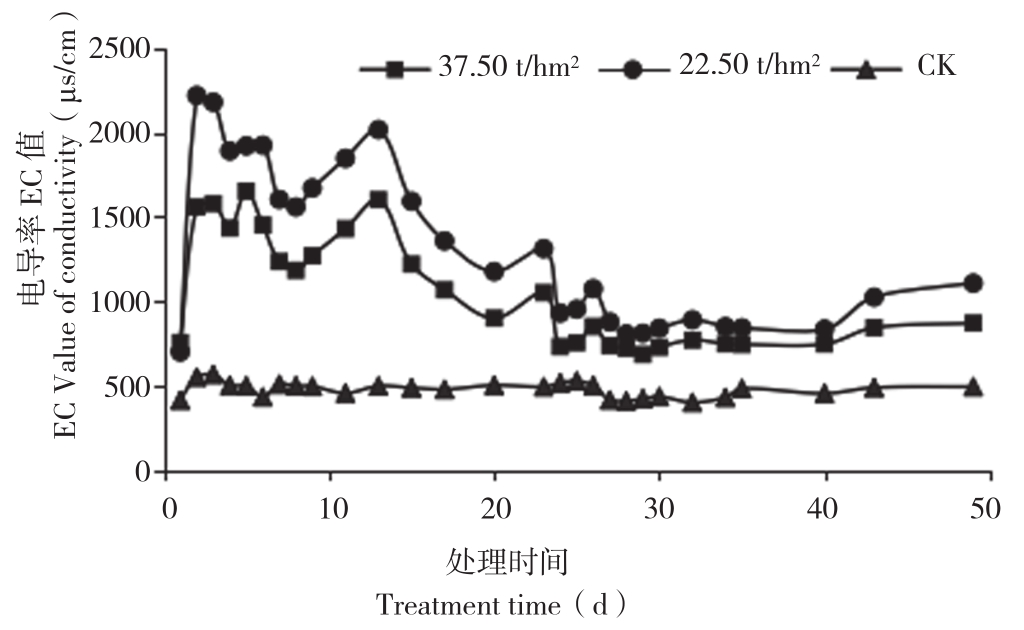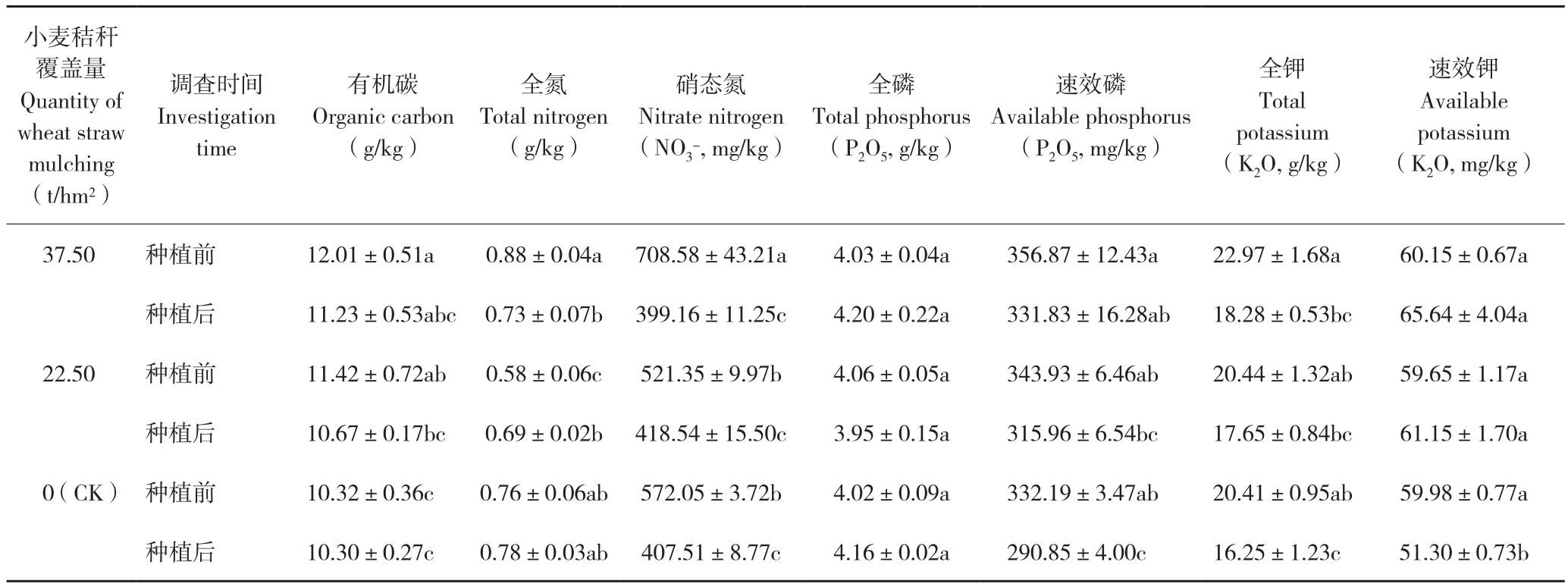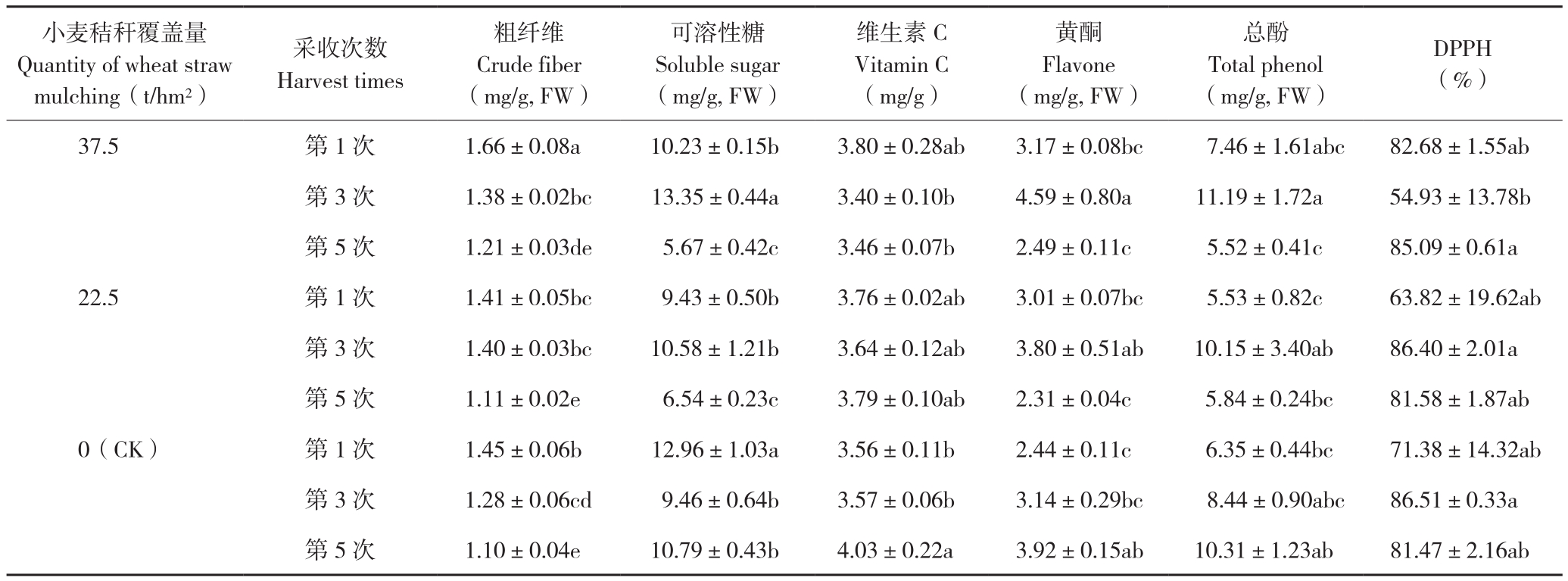【研究意义】近年来,设施蔬菜产业迅速发展,已经成为发展高效农业的重要亮点[1]。然而,设施蔬菜的周年种植,且在高温高湿的特殊环境,及过量施肥等农事操作下[2],设施内土壤出现了酸化、次生盐渍化、土传病害加重、养分失衡减少等一系列连作障碍问题,如今已成为影响设施栽培的一个重要限制因子[3-4]。过量施肥导致的土壤0~20 cm表层硝酸盐累积,是土壤盐渍化的一个突出原因[5],受土壤盐渍化影响的蔬菜也会表现出生长发育不良、产量降低、品质变差、病虫害严重等现象[6],通过灌水方式栽培水生蔬菜,可以使土壤表层盐分下渗,利用蔬菜来吸收硝态氮,不仅可以减少淋溶损失[7],而且土壤盐渍化问题也得以缓解,蔬菜产量品质也能得到提高,有利于促进设施蔬菜可持续发展。秸秆还田是我国一项重要有机培肥措施[8],农业农村部在《农业绿色发展技术导则(2018—2030年)》中也倡导秸秆还田、稻麦秸秆综合利用及肥水高效技术等。秸秆还田可以增加作物产量、提高土壤有机质含量,具有较好的经济效益和社会效益[9]。【前人研究进展】有研究表明,秸秆还田可以补充蔬菜生长所需的营养元素[10],也可以作为短期磷和钾的来源、长期氮和碳的来源[11],是构建肥沃耕层的关键措施。秸秆还田与相同数量的矿质氮肥相比,显著增加了土壤有机碳含量和作物产量[12]。Ma等[13]研究发现,相比秸秆沟埋、掺入表土、就地焚烧等秸秆处理方式而言,小麦秸秆土表覆盖是一种环保提倡的秸秆还田方式。秸秆覆盖也通常用于耕作系统中以改善土壤理化性质,通过覆盖来降低蒸发量、调节温度、提高养分利用率、抑制杂草、降低盐碱度等[14-15]。研究表明,相对于未覆盖的土壤,秸秆覆盖能增加稳定的有机碳含量[16],并进一步提高了微生物生物量,活性和潜在的N利用率[17],可见秸秆覆盖后,土壤环境更有利于土壤微生物生长。覆盖秸秆处理可以降低盐渍化土壤0~20、20~40 cm和0~100 cm土层的盐分[18]。【本研究切入点】在设施条件下,较高的土壤温度(通常为25~31℃)结合淹水可使秸秆更易分解[19],且秸秆还田长度越短越有利于其腐解[20]。将淹水栽培与秸秆覆盖相结合,不仅能缓解设施栽培土壤的盐渍化,且其效果随着秸秆覆盖量的增加而提高[21],较高的秸秆覆盖量对土壤质量和蔬菜产量也有更为明显的积极影响[22]。因此,采用37.50 t/hm2和22.50 t/hm2的高量秸秆覆盖还田方式,覆盖截段为10 cm的小麦短秸秆,通过淹水栽培蕹菜(Ipomoea aquatica Forsk.)进行试验。【拟解决的关键问题】探究高量截段小麦秸秆还田的腐解效应,其对蕹菜产量和品质的影响,以及对土壤性质的改善效果,旨在为设施蔬菜的可持续发展和秸秆的综合利用提供理论依据。
1 材料与方法
1.1 试验材料
试验在扬州大学水生蔬菜试验大棚内进行。试验地位于江苏省扬州市维扬区,地理坐标为119°01'~119°54' E、32°15'~33°25',属亚热带季风性湿润气候区。年平均降水量1 052.1 mm左右,无霜期约222 d,≥10℃累积温度约4 760 ℃,土壤为砂壤土。供试蕹菜品种为泰国柳叶蕹菜,小麦秸秆采用扬麦6号。
1.2 试验方法
试验于2017年4—11月在扬州大学水生蔬菜试验大棚内进行,利用内径长、宽、高分别为500、370、320 mm的塑料箱,箱内灌水后填装常规园土至25 cm深,保持5 cm浅水层。2017年4月15日,将小麦秸秆截断至10 cm,按22.50 t/hm2(折合每箱450 g)、37.50 t/hm2(折合每箱750 g)秸秆在箱内均匀铺设秸秆,浇水浸没秸秆并保持相同水位,以不覆盖小麦秸秆为对照,3次重复。于5月7日蕹菜苗高约10 cm时按4行6列、每箱24株种植蕹菜,根据长势分别于6月1日、6月26日、7月8日、7月19日、8月4日、8月27日、9月15日、9月26日用尿素进行追肥。
1.3 测定指标及方法
1.3.1 土表水层电导率和氧化还原电位的测定 于4月15日至6月2日期间,在小麦秸秆还田后 30 min以及第1、2、3、4、5、6、7、8、9、11、13、15、17、20、23、24、25、26、27、28、29、30、32、34、37、40、43、49 d 取土表水层,使用电导率测试仪和氧化还原电位测试仪测定土表水层电导率和氧化还原电位。
1.3.2 土壤养分含量的测定 于2017年4月15日、11月17日,采用五点取样法取蕹菜种植前后土壤深度约10 cm的表层土,测定土壤氮、磷、钾含量。其中,土壤有机碳含量采用重铬酸钾容量法-外加热法(NY/T 1121.6—2006)测定,土壤速效磷、速效钾均用Mehlich 3试剂浸提,速效磷含量采用钼锑抗比色法测定,速效钾含量采用火焰分光光度法[23]测定,硝态氮含量采用紫外分光光度法(GB/T 32737—2016)测定;全氮含量采用凯氏定氮法(H2SO4-H2O2消煮)[24]测定,全磷含量采用NaOH熔融-钼锑抗比色法[25]测定,全钾含量采用NaOH熔融-火焰光度法[26]测定。
1.3.3 蕹菜产量和品质的测定 于6月20日、7月17日、8月11日、9月8日、10月6日共5次对各处理蕹菜进行采样,其中10月6日为采收时间,CK因长势矮小延迟至10月13日采收,选取第1、3、5次采样的蕹菜为代表样品,测定植株的产量和品质。其中,蕹菜的全氮、全磷、全钾含量按1.3.2方法测定,黄酮含量、总酚含量和DPPH自由基清除率按谢冬惠等[27]方法测定,粗纤维含量按国家标准法(GB/T 5009.10—2003)测定,可溶性糖含量采用硫酸-苯酚法[28]测定,同时按以下公式计算养分(N、P或K)转移总量:
养分转移总量(kg/hm2)=∑每次采收产量(kg/hm2)×当次养分含量(mg/g)/1000
当蕹菜株高达30~35 cm时进行采收,同时计算蕹菜产量:
单次蕹菜产量(t/hm2)=∑单个重复单次采收产量(t/hm2)/3
蕹菜总产量(t/hm2)=∑单次蕹菜产量(t/hm2)
1.3.4 小麦秸秆腐解率的测定 每茬试验结束后,捞出尚未腐解的小麦秸秆,洗净后晒干、称质量,计算腐解率,试验结束后将未腐解秸秆仍翻耕还于田中。
腐解率(%)=(秸秆覆盖量-秸秆剩余量)/秸秆覆盖量×100
试验数据采用Excel 2007软件和DPS 7.05软件进行统计分析。
2 结果与分析
2.1 不同小麦秸秆覆盖量对土表水层电导率和氧化还原电位的影响
2.1.1 土表水层电导率 由图1可知,两个小麦秸秆覆盖处理的土表水层电导率呈现出前期迅速上升、而后波折下降、再上升、随后下降趋于平缓的趋势,CK的土表水层电导率一直趋于平缓,两个处理的土表水层电导率始终高于CK,小麦秸秆覆盖量22.5 t/hm2处理土表水层电导率也始终高于37.5 t/hm2处理。22.5 t/hm2处理的土表水层电导率处理后2 d达最大值2 220 μs/cm,随后波折下降,处理后第13 d达第二峰值2 018 μs/cm,随后较长时间维持在800~1 000 μs/cm。37.5 t/hm2处理5 d达到最大值1 653 μs/cm,随后下降,处理后13 d达到另一高峰1 602 μs/cm,随后较长时间稳定在750 μs/cm左右。CK的土表水层电导率基本稳定在400~550 μs/cm。两个处理出现的第1个峰值可能由于随着秸秆还田量的增加,溶液中可溶性离子浓度随之增加,土表水层电导率随之增加,第2个峰值主要可能因为秸秆腐解后效应导致,处理后23 d土表水层电导率有小幅跳跃升高应该与移栽蕹菜有关,处理后49 d,土表水层电导率的小幅上升应与施加尿素有关。

图1 不同小麦秸秆覆盖量对土表水层电导率的影响
Fig.1 Effects of different quantities of wheat straw mulching on conductivity of soil surface water layer
2.1.2 土表水层氧化还原电位 从图2可以看出,两个小麦秸秆覆盖处理的土表水层氧化还原电位均表现为前期快速下降,处理后3 d分别下降至-198 mV和-202 mV。37.5 t/hm2处理随后开始上升,处理后7 d开始趋于平缓;22.50 t/hm2处理在第一次下降后缓慢上升,至处理后8 d跳跃下降为最低值-212 mV后逐步趋于平缓,处理后20~30 d可能由于蕹菜进行了移栽,均有小幅波折,处理34 d后逐步上升,均高于0 mV。两个处理的土表水层氧化还原电位基本均低于CK。

图2 不同小麦秸秆覆盖量对土表水层氧化还原电位的影响
Fig.2 Effects of different quantities of wheat straw mulching on redox potential of soil surface water layer
2.2 不同小麦秸秆覆盖量对土壤养分含量的影响
从表1可以看出,种植蕹菜前后土壤的有机碳含量无显著差异,在种植蕹菜前,两个处理的有机碳含量显著高于CK,种植后处理与CK的差异不显著。种植前,小麦秸秆覆盖量22.5 t/hm2处理土壤的全氮含量显著低于CK和37.5 t/hm2处理,种植后两个处理的全氮含量与CK差异不显著。与种植蕹菜前相比,种植蕹菜后土壤硝态氮含量显著下降,且37.5 t/hm2处理降幅最为显著。种植蕹菜前与种植后相比,土壤的全钾含量显著下降,处理的速效钾含量均无显著差异,CK的速效钾含量显著下降,种植后,处理的速效钾含量显著高于CK。
2.3 不同小麦秸秆覆盖量对蕹菜产量、养分转移量和品质的影响
2.3.1 蕹菜产量 由图3可知,在第1次采收中,两个小麦秸秆覆盖处理的蕹菜产量均显著低于CK,可能与蕹菜幼苗过小尚未扎根、前期处理水层还原性较强有关;第3次采收时,三者已无显著差异;第4次采收中,两个处理的蕹菜产量显著高于CK;第5次采收中,22.50 t/hm2处理的蕹菜产量显著高于37.50 t/hm2处理和CK。
表1 不同小麦秸秆覆盖量对土壤养分含量的影响
Table 1 Effects of different quantities of wheat straw mulching on soil nutrient contents

注:同列数据后小写英文字母不同者表示差异显著。
Note: Different lowercase letters in the same column represent significant differences.
小麦秸秆覆盖量Quantity of wheat straw mulching(t/hm2)调查时间Investigation time有机碳Organic carbon(g/kg)全氮Total nitrogen(g/kg)硝态氮Nitrate nitrogen(NO3-, mg/kg)全磷Total phosphorus(P2O5, g/kg)速效磷Available phosphorus(P2O5, mg/kg)全钾Total potassium(K2O, g/kg)速效钾Available potassium(K2O, mg/kg)37.50 种植前 12.01±0.51a 0.88±0.04a 708.58±43.21a 4.03±0.04a 356.87±12.43a 22.97±1.68a 60.15±0.67a种植后 11.23±0.53abc 0.73±0.07b 399.16±11.25c 4.20±0.22a 331.83±16.28ab 18.28±0.53bc 65.64±4.04a 22.50 种植前 11.42±0.72ab 0.58±0.06c 521.35±9.97b 4.06±0.05a 343.93±6.46ab 20.44±1.32ab 59.65±1.17a种植后 10.67±0.17bc 0.69±0.02b 418.54±15.50c 3.95±0.15a 315.96±6.54bc 17.65±0.84bc 61.15±1.70a 0(CK) 种植前 10.32±0.36c 0.76±0.06ab 572.05±3.72b 4.02±0.09a 332.19±3.47ab 20.41±0.95ab 59.98±0.77a种植后 10.30±0.27c 0.78±0.03ab 407.51±8.77c 4.16±0.02a 290.85±4.00c 16.25±1.23c 51.30±0.73b
2.3.2 养分转移量 表2显示,小麦秸秆覆盖量37.50 t/hm2处理的蕹菜产量较CK略有下降,22.50 t/hm2处理较CK增产5 %,两个处理均比CK化肥减施14.30%,尤其是22.50 t/hm2处理更能达到减肥增产效果,可能是37.50 t/hm2处理尚未完全腐解、后期养分未完全释放所致。小麦秸秆的最适宜覆盖量需要进一步探究。两个处理养分转移总量、钾转移量均高于CK,可在秸秆覆盖前施用基肥时适当减少钾肥用量。

图3 不同小麦秸秆覆盖量对蕹菜产量的影响
Fig.3 Effects of different quantities of wheat straw mulching on yield of water spinach
小写英文字母不同者表示差异显著
Different lowercase letters in the figure represent significant differences among different treatments
2.3.3 蕹菜品质 由表3可知,第1次采收时,小麦秸秆覆盖量37.50 t/hm2处理蕹菜的粗纤维含量显著高于22.50 t/hm2处理和CK,第3次、第5次采收中两个处理的粗纤维含量与CK差异均不显著。第1次采收、第5次采收时,两个处理蕹菜的可溶性糖含量显著低于CK,两个处理间无显著差异,第3次采收时37.50 t/hm2处理可溶性糖含量显著高于CK和22.50 t/hm2处理。在第1次、第3次采收中,两个处理蕹菜的维生素C、总酚含量与CK基本无显著差异,第5次采收中37.50 t/hm2处理的维生素C、总酚含量显著低于CK。第1次采收时,两个处理蕹菜的黄酮含量与CK无显著差异,第3次采收37.50 t/hm2处理黄酮含量显著高于CK,第5次采收时两个处理的黄酮含量显著低于CK。第1次、第5次采收的两个处理的DPPH自由基清除率与CK相比无显著差异,第3次采收的37.50 t/hm2处理DPPH自由基清除率显著低于CK。第5次采收的CK可溶性糖、黄酮与总酚含量相比处理较高可能与补充施肥有关。
表2 不同小麦秸秆覆盖量对养分转移量的影响
Table 2 Effects of different quantities of wheat straw mulching on nutrient transfer of water spinach

小麦秸秆覆盖量Quantity of wheat straw mulching(t/hm2)总产量Total yield(g)比CK±Compared with CK ±(%)折合产量Equivalent yield(t/hm2)总施肥量Total fertilizer application(kg/hm2)化肥减施比例Reduced proportion of fertilizer(%)折合养分转移总量Total nutrient transfer(kg/hm2)N P2O5 K2O NPK总量Total NPK 37.50 2701.30 -1.0 146.09 450 14.30 237.00 247.50 636.00 1120.50 22.50 2873.00 +5.0 155.37 450 14.30 235.50 246.00 762.00 1243.50 0(CK) 2735.10 147.92 525 - 247.50 274.95 499.95 1022.40
表3 不同小麦秸秆覆盖量对蕹菜品质的影响
Table 3 Effects of different quantities of wheat straw mulching on quality of water spinach

注:同列数据后小写英文字母不同者表示差异显著。
Note: Different lowercase letters in the same column represent significant differences among different treatments.
小麦秸秆覆盖量Quantity of wheat straw mulching(t/hm2)采收次数Harvest times粗纤维Crude fiber(mg/g, FW)可溶性糖Soluble sugar(mg/g, FW)维生素C Vitamin C(mg/g)黄酮Flavone(mg/g, FW)总酚Total phenol(mg/g, FW)DPPH(%)37.5 第1次 1.66±0.08a 10.23±0.15b 3.80±0.28ab 3.17±0.08bc 7.46±1.61abc 82.68±1.55ab第 3 次 1.38±0.02bc 13.35±0.44a 3.40±0.10b 4.59±0.80a 11.19±1.72abc 54.93±13.78b第 5 次 1.21±0.03de 5.67±0.42c 3.46±0.07b 2.49±0.11c 5.52±0.41cbc 85.09±0.61a 22.5 第1次 1.41±0.05bc 9.43±0.50b 3.76±0.02ab 3.01±0.07bc 5.53±0.82cbc 63.82±19.62ab第 3 次 1.40±0.03bc 10.58±1.21b 3.64±0.12ab 3.80±0.51ab 10.15±3.40abb 86.40±2.01a第 5 次 1.11±0.02e 6.54±0.23c 3.79±0.10ab 2.31±0.04c 5.84±0.24bcb 81.58±1.87ab 0(CK) 第1次 1.45±0.06b 12.96±1.03a 3.56±0.11b 2.44±0.11c 6.35±0.44bcb 71.38±14.32ab第 3 次 1.28±0.06cd 9.46±0.64b 3.57±0.06b 3.14±0.29bc 8.44±0.90abc 86.51±0.33a第 5 次 1.10±0.04e 10.79±0.43b 4.03±0.22a 3.92±0.15ab 10.31±1.23abb 81.47±2.16ab
2.4 小麦截段秸秆高量还田后的腐解效率比较
由表4可知,从2017年4月15日至10月13日,经夏秋季节182 d的腐解,小麦秸秆覆盖量37.50 t/hm2处理腐解率为63.91%,22.50 t/hm2处理腐解率为91.00%。可见,小麦秸秆覆盖量越大,秸秆腐解速率越低,22.50 t/hm2处理经182 d腐解后已经基本不影响翻耕。
表4 小麦截段秸秆高量还田后的腐解效率比较
Table 4 Comparison of decomposition efficiency of high quantity of wheat straws returned to field

注:同列数据后小写英文字母不同者表示差异显著。
Note: Different lowercase letters in the same column represent significant differences.
小麦秸秆覆盖量Quantity of wheat straw mulching(t/hm2)种植后剩余量(g/盒)Straw residue(g/box)腐解率Decomposition rate(%)37.5 270.67±49.73a 63.91±6.63b 22.5 40.50±11.56b 91.00±2.57a
3 讨论
3.1 不同小麦秸秆覆盖量对土壤性质的影响
本试验中,两个处理土壤有机碳含量变化均无显著差异,可能与短规格切段创伤面大、腐解释放养分较为彻底有关。有研究表明,长达10年的免耕秸秆覆盖,土壤有机碳含量仅在表层增加了33%[29],所以经过翻耕后的土壤,短期内其有机碳含量变化可能尚不显著。试验中,土壤表层硝态氮含量均显著下降,其中37.50 t/hm2处理降幅最大、达43.69%,与小麦秸秆腐解消耗较多氮素有关,这与刘方明等“土壤硝态氮随着玉米秸秆还田量的增加而减少”的结论[30]相一致,添加秸秆也可以改善盐渍化土壤的团聚体结构、改良土壤的物理性质、缓解设施内土壤酸化和病害等问题[31]。地下水生态系统中的一个关键环境问题是硝酸盐污染,有研究表明,与非秸秆还田区相比,秸秆还田区浅层地下水中的NO3-浓度下降,可见秸秆还田区发生了反硝化作用,对地下水硝酸盐含量减少、水质改善有一定积极影响[32],本试验仅探究了0~10 cm表层土壤的硝酸盐含量,可考虑在下茬试验中继续探究秸秆覆盖后深层土壤的硝酸盐含量变化。有研究表明,返回农田的秸秆可以抵消作物所需肥料中所有钾肥(K2O)、大部分磷肥(P2O5)和部分氮肥(N)[33],本试验中两个处理土壤速效磷、速效钾含量变化差异均不显著,CK则显著下降,可见水旱轮作的生态模式与秸秆还田有机结合,不仅可以有效缓解土壤连作障碍、淹杀有害病菌,同时可以起到增加土壤养分、改良土壤肥力的作用,可考虑在下茬种植前施基肥时适当减少磷、钾肥用量。
3.2 不同小麦秸秆覆盖量对蕹菜产量及养分转移的影响
本试验中,小麦秸秆覆盖量37.50 t/hm2处理蕹菜的产量较CK略有下降,可能与移栽时蕹菜过小尚未扎根有关,也可能与高量秸秆还田,土壤碳氮比失调、前期秸秆快速分解与苗争氮有关[34],22.50 t/hm2处理较CK增产5%,这与Chen 等[35]、Wang等[36]研究结果相一致,且两个处理均较CK化肥减施14.30%,可见,短规格切段小麦秸秆腐解率较高而释放养分较多,可对当茬蔬菜起到较好的增产减肥效果。秸秆全量还田下,带入的平均养分相当于化肥用量的38.40%(N)、18.90%(P2O5)和 85.50%(K2O)[37]。秸秆含有丰富的钾素资源,通过秸秆还田是利用秸秆钾资源最直接、最简便和最有效的途径[38],有研究表明秸秆还田对作物产量的积极影响在低产季节表现更为有效,秸秆还田也能显著增加作物对钾的吸收[39],小麦秸秆覆盖后,两个处理转移的钾含量均高于CK,因此可考虑在秸秆覆盖前施用基肥时适当减少钾肥用量,同时可考虑在高量秸秆还田下适量增施氮肥,调节合适土壤碳氮比[40],达到增加产量、改善土壤性质的效果,两个处理蕹菜对氮磷钾转移总量均高于CK,可见,速生性水生蔬菜对养分吸收转移量大的特点,有望利用其缓解由于超量施用化肥导致的盐渍化。
3.3 不同小麦秸秆覆盖量对蕹菜品质的影响
第3次采收时,小麦秸秆覆盖量37.50 t/hm2处理蕹菜的可溶性糖、黄酮含量均高于CK。在第5次采收时,两个处理蕹菜的可溶性糖、黄酮和总酚含量低于CK,可能与CK延期采收、补充施肥有关。本研究中高量秸秆还田对蔬菜品质的改善效果尚不显著,可考虑探究后期旱作对蔬菜作物的影响及连续秸秆还田结合水旱轮作对蔬菜作物品质的改善效果。
3.4 不同小麦秸秆覆盖量对腐解率的影响
采用10 cm切段小麦秸秆,按37.50 t/hm2和22.50 t/hm2覆盖量在大棚内淹水栽培蕹菜,经夏秋季节182 d的腐解,37.50 t/hm2与22.50 t/hm2覆盖量的腐解率分别为63.91%、91.00%,均高于周东兴等通过埋土165 d后的秸秆腐解率49.30%~56.05%[41],大幅高于谭可菲等水稻秸秆水田翻埋还田的腐解率44.30%,22.50 t/hm2覆盖处理的腐解率也高于谢梦薇等[42]22.50 t/hm2截为2段(约40 cm)水稻秸秆的腐解率72.74%[21],与葛选良等研究中提到“5 cm的秸秆腐解率高于15 cm的秸秆”[43]有类似趋势。本研究进一步证明了设施水田高温高湿加上有氧发酵的环境条件下,有利于秸秆腐解,且秸秆切段越短,创伤面越大,与微生物的接触越多,越有利于其腐解[44]。通过覆盖还田代替传统深埋还田方式,还可避免秸秆埋土后产生还原性有害物质,对作物生长产生有害影响。本试验采用的是小麦秸秆10 cm规格,在实际生产操作中可采用机械捆装碎秸秆,便于直接还田,也可提高秸秆的腐解率,需要进一步探究。
4 结论
通过土表覆盖高量短规格小麦秸秆并淹水种植水生蔬菜,小麦短秸秆的腐解率总体较高,37.50、22.50 t/hm2覆盖量处理的腐解率分别为63.91%、91.00%,且小麦秸秆释放了较多养分,22.50 t/hm2覆盖量处理较CK增产5%,两个处理均较CK化肥减施14.30%。高量小麦短秸秆还田,不仅能补充土壤中的速效磷、速效钾含量,且能有效改善土壤盐渍化程度,37.50 t/hm2处理的土壤硝态氮含量降幅高达43.69%。可考虑继续深入研究,对基肥进行调整,增施氮肥,减少磷钾肥的施入,通过高量秸秆还田,探究其对蔬菜产量、品质及土壤性质的影响,揭示秸秆覆盖的技术原理与效应,为确定合理利用的秸秆资源及培肥地力提供一定的理论依据和技术支撑。
[1] MA Y, LIU Z H, XI B D, SONG X H, LI Q L, QI Y J, JIN M Y, GUO Y.Characteristics of groundwater pollution in a vegetable cultivation area of typical facility agriculture in a developed city[J].Ecological Indicators, 2018, 105: 709-716.doi:10.1016/j.ecolind.2018.10.056.
[2] TIAN Y Q, WANG Q, ZHANG W H, GAO L H.Reducing environmental risk of excessively fertilized soils and improving cucumber growth by Caragana microphylla -straw compost application in long-term continuous cropping systems[J].Science of the Total Environment,2016, 544:251-261.doi:10.1016/j.scitotenv.2015.11.091.
[3] WU F, LI N X, ZHANG J J, GUO S Y.The design about early warning of vegetable disease in facility agriculture[J].Journal of Physics:Conference Series, 2019, 1168(3): 32-52.doi: 10.1088/1742-6596/1168/3/ 032052.
[4] HU W Y, ZHANG Y X,HUANG B, TENG Y.Soil environmental quality in greenhouse vegetable production systems in eastern China: Current status and management strategies.[J].Chemosphere, 2017, 170: 183-195.doi: 10.1016/j.chemosphere.2016.12.047.
[5] CHANG J, WU X, LIU A Q, WANG Y, XU B, YANG W, LAURA A.Assessment of net ecosystem services of plastic greenhouse vegetable cultivation in China[J].Ecological Economics, 2010, 70(4): 740-748.doi: 10.1016/j.ecolecon.2010.11.011.
[6] SONG X L, SUN R J, CHEN W F, WANG M H.Effects of surface straw mulching and buried straw layer on soil water content and salinity dynamics in saline soils[J].Canadian Journal of Soil Science,2019,100(1): 58-68.doi:10.1139/cjss-2019-0038.
[7] 王永生.宁夏黄灌区农田有机质对土壤硝态氮淋失量的影响研究[D].北京:中国农业科学院,2011.doi: 10.7666/d.Y1932539.WANG Y S.Study on the effect of farmland organic matter on the loss of soil nitrate nitrogen in yellow irrigation area of Ningxia[D].Beijing:Chinese Academy of Agricultural Sciences, 2011.
[8] LI H, DAI M W, DAI S L,DONG X J.Current status and environment impact of direct straw return in China’s cropland-A review[J].Ecotoxicology and Environmental Safety, 2018, 159: 293-300.doi:10.1016/j.ecoenv.2018.05.014.
[9] ZHU L Q, HU N J, YANG M F, ZHAN X H, ZHANG Z W.Effects of different tillage and straw return on soil organic carbon in a rice-wheat rotation system.[J].PLoS ONE, 2017, 9(2).doi: 10.1371/journal.pone.0088900.
[10] 董林林,王海侯,陆长婴,金梅娟,朱兴连,沈园,沈明星.秸秆还田量和类型对土壤氮及氮组分构成的影响[J].应用生态学报,2019, 30(4):1143-1150.doi: 10.13287/j.1001-9332.201904.018.DONG L L, WANG H H, LU C Y,JIN M J, ZHU X L, SHEN Y, SHEN M X.Effects of straw returning amount and type on soil nitrogen and its composition[J].Journal of Applied Ecology, 2019, 30(4):1143-1150.doi: 10.13287/j.1001-9332.201904.018.
[11] YAN C, YAN S S, JIA T Y, DONG S K, MA C M, GONG Z P.Decomposition characteristics of rice straw returned to the soil in northeast China[J].Nutrient Cycling in Agroecosystems, 2019, 114(3): 211-224.doi: 10.1007/s10705-019-09999-8.
[12] XIA L L, LAM S K, WOLF B J, KIESE R, CHEN D,KLAUS B B.Trade-offs between soil carbon sequestration and reactive nitrogen losses under straw return in global agroecosystems[J].Global Change Biology, 2018, 24(12): 5919-5932.doi: 10.1111/ gcb.14466.
[13] MA J, XU H, YAGI K, CAI Z C.Methane emission from paddy soils as affected by wheat straw returning mode[J].Plant and Soil, 2008, 313(2): 167-174.doi: 10.1007/s11104-008-9689-y.
[14] NGOSONG C, OKOLLE J N, TENING A S.Mulching: A sustainable option to improve soil health// Soil Fertility Management for Sustainable Development[M].Springer, Singapore, 2019: 231-249.doi:10.1007/978-981-13-5904-0_11.
[15] AKHTAR K, WANG W, KHAN A, REN G X, AFRIDI M Z, FENG Y Z, YANG G.Wheat straw mulching offset soil moisture deficient for improving physiological and growth performance of summer sown soybean[J].Agricultural Water Management, 2019, 211: 16-25.doi:10.1016/j.agwat.2018.09.031.
[16] JHA P, HATI K M, DALAL R C, DANG Y P, KOPITTKE P M,MENZIES N W.Soil carbon and nitrogen dynamics in a Vertisol following 50 years of no-tillage, crop stubble retention and nitrogen fertilization[J].Geoderma, 2020, 358: 113996.doi: 10.1016/j.geoderma.2019.113996.
[17] TU C, RISTAINO J B, HU S.Soil microbial biomass and activity in organic tomato farming systems: Effects of organic inputs and straw mulching[J].Soil Biology and Biochemistry, 2006, 38(2): 247-255.doi: 10.1016/j.soilbio.2005.05.002.
[18] LI J G, PU L J, HAN M F, ZHU M, ZHANG R S, XIANG Y Z.Soil salinization research in China: advances and prospects[J].Journal of Geographical Sciences, 2014, 24(5): 943-960.doi: 10.1007/s11442-014-1130-2.
[19] WU Y P, LIU T, PENG Q, SHAABAN M.Effect of straw returning in winter fallow in Chinese rice fields on greenhouse gas emissions:evidence from an incubation study[J].Soil Research, 2015, 53(3):298-305.doi: 10.1071/SR14261.
[20] TARAFDAR J C, MEENA S C, KATHJU S.Influence of straw size on activity and biomass of soil microorganisms during decomposition[J].European Journal of Soil Biology, 2001, 37(3): 157-160.doi:10.1016/S1164-5563(01)01084-6.
[21] 谢梦薇,江解增,朱丽丽,张路,李换平.水稻秸秆覆盖量对水生蔬菜产量及土壤性质的影响[J].贵州农业科学,2018, 46(12): 104-108.XIE M W, JIANG J Z, ZHU L L, ZHANG L, LI H P.Effect of rice straw coverage on the yield of aquatic vegetables and soil properties[J].Guizhou Agricultural Science, 2018, 46(12): 104-108.
[22] ZHAO Y G, WANG S J, LI Y, ZHUO Y Q, LIU J.Effects of straw layer and flue gas desulfurization gypsum treatments on soil salinity and sodicity in relation to sunflower yield[J].Geoderma, 2019, 352: 13-21.doi: 10.1016/j.geoderma.2019.06.004.
[23] 曹晓倩,吕新.Mehlich 3法测定新疆土壤速效磷和速效钾的可行性研究[J].石河子大学学报(自然科学版),2011, 29(2): 140-144.doi:10.13880/j.cnki.65-1174/n.2011.02.025.CAO X Q, LYU X.Feasibility study of Mehlich 3 method for the determination of soil available P and K in Xinjiang[J].Journal of Shihezi University(Natural Science Edition), 2011, 29(2): 140-144.doi:10.13880/j.cnki.65-1174/n.2011.02.025.
[24] 王琳.凯氏法测定土壤全氮的方法改进[J].环境监控与预警,2013, 5(3): 33-37.WANG L.Improvement of Kjeldahl method for determination of soil total nitrogen[J].Environmental Monitoring and Early Warning,2013, 5(3): 33-37.
[25] GE N N, SJI Y, YANG X L,ZHANG Q Y,LI X Z,JIA X X,SHAO M A,WEI X R.Distribution of soil organic carbon, total nitrogen, total phosphorus and water stable aggregates of cropland with different soil textures on the Loess Plateau, Northwest China[J].The Journal of Applied Ecology, 2017, 28(5): 1626-1632.doi: 10.13287/j.1001-9332.201705.021.
[26] TAN D S, JIN J Y, HUANG S W, LI S T,HE P.Effect of long-term application of K fertilizer and wheat straw to soil on crop yield and soil K under different planting systems[J].Agricultural Sciences in China, 2007, 6(2): 200-207.doi: 10.1016/S1671-2927(07)60035-2.
[27] 谢冬惠,徐静,李治明,梁振益.小叶榕气生根总酚酸和总黄酮含量测定及其抗氧化活性比较[J].热带生物学报,2016, 7(3): 373-375.doi:10.15886/j.cnki.rdswxb.2016.03.017.XIE D H, XU J, LI Z M, LIANG Z Y.Determination of total phenolic acid and total flavonoids in aerial roots of Ficus microcarpa and comparison of their antioxidant activities[J].Journal of Tropical Biology, 2016, 7(3): 373-375.doi: 10.15886/j.cnki.rdswxb.2016.03.017.
[28] 康琪,朱若华.苯酚-硫酸法测定可溶性膳食纤维-聚葡萄糖含量的研究[J].首都师范大学学报(自然科学版),2007, 28(6):38-41.doi: 10.19789/j.1004-9398.2007.06.010.KANG Q, ZHU R H.Study on the determination of soluble dietary fiber polydextrose by phenol sulfuric acid method[J].Journal of Capital Normal University(Natural Science Edition), 2007, 28(6): 38-41.doi: 10.19789/j.1004-9398.2007.06.010.
[29] HUMBERTO B C, LAI R.Soil structure and organic carbon relationships following 10 years of wheat strawmanagement in no-till[J].Soil and Tillage Research, 2007, 95(2): 240-254.doi: 10.1016/j.still.2007.01.004.
[30] 刘方明,高玉山,孙云云,窦金刚,侯中华,刘慧涛,王立春.秸秆腐解规律和养分释放特征影响因素的研究进展[J].湖北农业科学,2018, 57(4):5-7,14.doi: 10.14088/j.cnki.issn0439-8114.2018.04.001.LIU F M, GAO Y S, SUN Y Y, DOU J G, HOU Z H, LIU H T, WANG L C.Research progress on influencing factors of straw decomposition law and nutrient release characteristics[J].Hubei Agricultural Sciences, 2018, 57(4):5-7,14.doi: 10.14088/ j.cnki.issn0439-8114.2018.04.001.
[31] GUO L J, ZHANG Z S, WANG D D, LI C F, CAO C G.Effects of short-term conservation management practices on soil organic carbon fractions and microbial community composition under a rice-wheat rotation system[J].Biology and Fertility of Soils, 2015, 51(1): 65-75.doi: 10.1007/s00374-014-0951-6.
[32] LI R F, RUAN X H, BAI Y, MA T H, LIU C Q.Effect of wheat-maize straw return on the fate of nitrate in groundwater in the Huaihe River Basin, China[J].Science of the Total Environment, 2017, 592: 78-85.doi: 10.1016/j.scitotenv.2017.03.029.
[33] YIN H J, ZHAO W Q, LI T, CHEN X Y, LIU Q.Balancing straw returning and chemical fertilizers in China: Role of straw nutrient resources[J].Renewable and Sustainable Energy Reviews, 2018, 81(2): 2695-2702.doi: 10.1016/j.rser.2017.06.076.
[34] YANG H S, YANG B, DAI Y J, XU M M, KOIDE R T, WANG X H,LIU J, BIAN X M.Soil nitrogen retention is increased by ditch-buried straw return in a rice-wheat rotation system[J].European Journal of Agronomy, 2015, 69: 52-58.doi: 10.1016/j.eja.2015.05.005.
[35] CHEN J, ZHENG M J, PANG D W, YIN Y P, HAN M M, LI Y X, LUO Y L, XU X, LI Y, WANG Z L.Straw return and appropriate tillage method improve grain yield and nitrogen efficiency of winter wheat[J].Journal of Integrative Agriculture, 2017, 16(8): 1708-1719.doi:10.1016/S2095-3119(16)61589-7.
[36] WANG J Z, WANG X J, XU M G, FENG G, ZHANG W J, LU C A.Crop yield and soil organic matter after long-term straw return to soil in China[J].Nutrient Cycling in Agroecosystems, 2015, 102(3): 371-381.doi: 10.1007/s10705-015-9710-9.
[37] 宋大利,侯胜鹏,王秀斌,梁国庆,周卫.中国秸秆养分资源数量及替代化肥潜力[J].植物营养与肥料学报,2018, 24(1): 1-21.SONG D L, HOU S P, WANG X B, LIANG G Q, ZHOU W.Quantity of straw nutrient resources and potential of alternative fertilizer in China[J].Journal of Plant Nutrition and Fertilizer, 2018, 24(1): 1-21.
[38] YADAV S K, BENBI D K, TOOR A S.Effect of long-term application of rice straw, farmyard manure and inorganic fertilizer on potassium dynamics in soil[J].Archives of Agronomy and Soil Science, 2019,65(3): 374-384.doi: 10.1080/03650340.2018.1505040.
[39] BAI Y L, WANG L, LU Y L, YANG L P, ZHOU L P, NI L, CHENG M F.Effects of long-term full straw return on yield and potassium response in wheat-maize rotation[J].Journal of Integrative Agriculture, 2015,14(2): 2467-2476.doi: 10.1016/S2095-3119(15)61216-3.
[40] ELLIOTT R D Y, NICOLAS B, EDWARD A, ATTANDA M L, NAAB J, JOEL H, EULOGE K A.Combining no-tillage, rice straw mulch and nitrogen fertilizer application to increase the soil carbon balance of upland rice field in northern Benin[J].Soil and Tillage Research,2016, 163: 152-159.doi: 10.1016/j.still.2016.05.019.
[41] 周东兴,王广栋,邬欣慧,李晶,金聪敏,王恩泽.不同还田量对秸秆养分释放规律及微生物功能多样性的影响[J].土壤通报,2018,49(4): 848-855.doi: 10.19336/j.cnki.trtb.2018.04.13.ZHOU D X, WANG G D, WU X H, LI J, JIN C M, WANG E Z.Effect of different amount of returning field on nutrient release and microbial functional diversity of straw[J].Soil Bulletin, 2018, 49(4): 848-855.doi: 10.19336/j.cnki.trtb.2018.04.13.
[42] 谭可菲,王麒,刘传增,马波,胡继芳,赵富阳,曾宪楠.黑龙江西部地区水稻秸秆腐解特征研究[J].中国稻米,2018, 24(4): 96-98.TAN K F, WANG Q, LIU CHUAN Z, MA B, HU J F, ZHAO F Y, ZENG X N.Study on the decomposition characteristics of rice straw in the western region of Heilongjiang Province[J].China Rice, 2018, 24(4):96-98.
[43] 葛选良,于洋,钱春荣.还田作物秸秆腐解特性及相关影响因素的研究进展[J].农学学报,2017, 7(7):17-21.GE X L, YU Y, QIAN C R.Research progress on decomposition characteristics and related influencing factors of returned crop straw[J].Journal of Agronomy, 2017, 7(7): 17-21.
[44] 赵聪,曹莹菲,刘克,薛泉宏,吕家珑.室内模拟条件下玉米秸秆的分解特征及物质组成变化[J].干旱地区农业研究,2014, 32(4):183-186.ZHAO C, CAO Y F, LIU K, XUE Q H, LV J L.Decomposition characteristics and material composition changes of corn straw under indoor simulation conditions[J].Agricultural Research in Arid Areas, 2014, 32(4): 183-186.